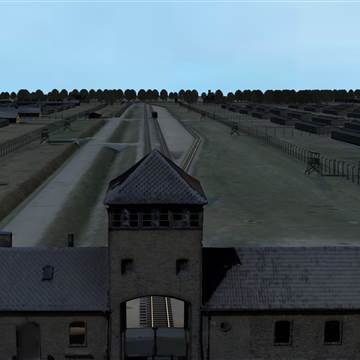MAINZ, Germany — Catching the last surviving Nazi war criminals isn’t easy. In the past, officials have had to dig through piles of yellowing and dusty documents, and even then the suspects often claim they never saw the atrocities being carried out around them.
But now investigators, prosecutors and judges are able to rely on a new technological tool — one that allows them to essentially travel back in time to see for themselves.
German experts have constructed a detailed digital model of Hitler’s Auschwitz-Birkenau extermination camp, where more than 1.1 million people were murdered during World War II.


Using virtual-reality googles, investigators can now walk around the camp in the shoes of former SS soldiers, analyzing the terrain through the eyes of the suspect.
“The model can be used in trials to counter the objection of suspects who claim that they did not witness executions or marches to gas chambers from their vantage point,” said Jens Rommel, head of Germany’s federal office for the investigation of Nazi war crimes.
The digital camp has been rendered in harrowing detail by experts from Bavaria’s State Criminal Office (LKA). It allows investigators wearing the VR goggles to even climb the watchtowers and observe how prisoners would have been moved around the 15-mile camp.
“Because the former crematoriums and other installations had been completely destroyed, we had to remodel them with the help of old construction plans,” according to 43-year-old Ralf Breker, a forensics software developer at the LKA who helped build the model.
He calls it “a tool with extraordinary added value.”


Breker and his team first visited the camp in 2013 and have used a variety of sources to reconstruct what is perhaps the most infamous site of the Nazi extermination program. The same year, forensics experts scanned the site with lasers, capturing parts of the fence, watchtowers and barracks.
His team combined the 3-D model with aerial photographs for greater accuracy, and the camp can be viewed in both winter and summer weather conditions.
In the future, Breker hopes to advance the technology so that two or more people can wear the virtual-reality googles and see each other inside the camp.
The computer simulation is designed to help prosecute the last remaining officials complicit in the Nazi’s Final Solution — the murder of 6 million Jews and other persecuted groups.
Rommel, the head Nazi hunter, leads a team of six judges and prosecutors responsible for finding these suspects and bringing them to court. His team applauds the technology, which is used to scrutinize the suspects’ claims of innocence once in court.
In the past four years, Rommel’s team has found 30 Auschwitz suspects and handed their cases over to the courts. They have also submitted the details of three cases from the Majdanek death camp and eight from the concentration camp at Stutthof.
He said they have at least a dozen other cases currently in the pipeline that they soon hope to bring to prosecution.
For Breker, who often encounters chilling murder scenes during his day job, building the Auschwitz-Birkenau model was “one of the most difficult tasks” he has experienced.
“The legacy [of the camp] and my encounter with the site of mass killings was very encumbering,” he said.







